| Executive NavCenter 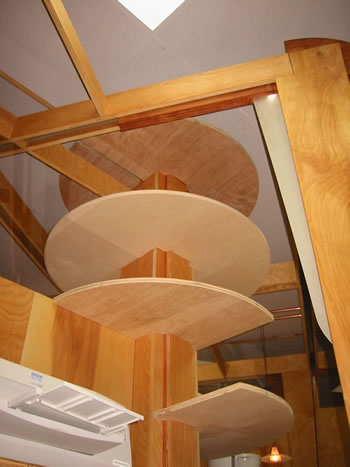
Prototypes
see companion piece: Executive NavCenter Concept
link JOSEKI Offices 2002 [link] | | A prototype of the executive NavCenter has to involve all 7 Domains [link] of the Taylor System. It cannot be approached just as a physical environment which is what most architecture and interior design does today. There are four MG Taylor/SFIA-Master Builders/AI projects that I will profile here as “prototypes” of the Executive NavCenter: Bill Stead’s office at the VCBH; the VCH Executive Offices; the WorkConservatory; and, the Master’s Collaboration Studio. Each of these get at some facet of the subject and, together, begin to make a comprehensive statement regarding housing and augmenting the executive routine [link]. | click on pictures below to go to these projects | | 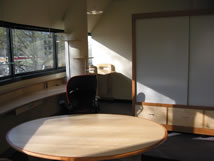 | | Bill Stead’s Office is a deliberate effort at augmenting an executive-knowledge-worker via his work environment, the adjacent NavCenter how his support person functions in concert with him. | | 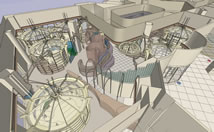 | | The VCH Executive offices constitute our most comprehensive statement: process, environment and tools, in support of the executive routine. | | 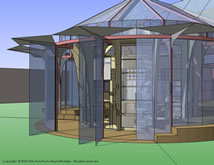 | | The WorkConservatory is designed to provide home work environments of great beauty while better integrating work-life and life-style for the knowledge-era; they also demonstrate Usonian [link] living principles. | | 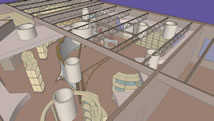 | | The Master’s Collaboration Center is the environment in which the Master’s NavCenter, new campus and School-of-the-Future will be designed. | | | The purpose of prototypes is to push the state-of-the-art in a project within a set of defined risks. In the case of these four projects, there is no question that the environments will function more or less as planned. There are two aspects that are being tested: first, certain structural, mechanical and assembly aspects of the physical structures; and second, certain work routines that are well established in the NavCenter/DesignShop experience but far less so in the day-to-day work environment. Both of these aspects will be covered in this document, however, the emphasis will be on the latter: the actual work processes and how they can be successfully embedded into the daily work habits of executive knowledge-workers in a wide variety of circumstances. | | These four prototypes will constitute the bulk of our R&D energies through 2004. The following 7 Domains Analysis will focus not only on what it is we are building - and why - but also on what it is we expect to get out of each exercise. This analysis, of course will focus on those aspects most relevant to the executive NavCenter concept and functioning. Each of the projects have their own web pages and you can get additional information on each of them by clicking on their picture/drawings above. | | 7 Domains Analysis of the Prototypes | | Each of these projects are different in scale, scope and their implications. Each address different client needs and market opportunities. Each, however, are the same at their root which is how does the personal executive routine work. Bill Stead’s Office is the smallest project in scope (unless you account that it is part of an existing 18,000 square foot NavCenter) - and the most intimate. While not large, as far as MG Taylor environments generally go, the VCH Executive Office is the most complex and integrated environment we have designed to date. The way-of-working issue is central to this project and involves an entire executive staff of 15 [link]. The WorkConservatory is unique for us in several aspects: first, it is a stand alone product to be delivered through an entirely different channel than our traditional work. Second, it our first serious step into the home as a marketplace. Third, the process aspect is not bundled with the market offering - it will be an aftermarket opportunity that will be serviced through the web. Finally, the WorkConservatory has the potential of becoming a far greater number of installations than our present practice experiences. The Master’s Collaboration Studio is a small NavCenter but one with a specific mission. It will be used to design and project manage three Master’s projects and it will be home to a Center Master who will be the main recipient, and transfer agent, of the Taylor processes to the Master’s organization and ValueWeb. This emphasis on project management and on knowledge-transfer, through a single agent, makes it unique from other NavCenters and a prototype of an entirely new transfer process. | | The central theme that ties these diverse projects together is embedding a way-of-working, in addition to the formal processes associated with a Taylor NavCenter and DesignShop expereinces, into the personal work-life style of specific individuals. This is the creating of new work-habits [link] and involves the making of strong-memory [link] and has been the goal of our work from the beginning. It is with these projects, however, that the first real opportunities, and the challenges associated with them, have presented themselves. This is what makes these four projects prototypes; it is because they plow new ground and will take extraordinary work and documentation to accomplish. These projects focus on personal work habitat first - as a vantage point - with work-teams, Group Genius, networking and ValueWeb building as an extension of this personal process. This line of approach is not contradictory to but the opposite direction from our work - other than what we have done for ourselves personally - of the last 25 years. | | circumstances_of_knowledge | BODY OF KNOWLEDGE All knowledge is personal, of course. What makes what we call social knowledge is the merging of several circumstances: a system that manages the artifacts and objects of knowledge in a way that makes it accessible to a community; the embedded memory, in a community of individuals, of certain stories that illustrate social origin, principles of behavior and important lessons learned - this is called a culture; curious humans who actively and systematically engage in the discovery, use, documentation and transfer of what they have learned - today, we call these KnowledgeWorkers. These conditions conspire [to breathe together] to make a BODY of knowledge. co | | PROCESS DESIGN and FACILITATION An indivi co | | TRAINING, EDUCATION and LEARNING An indivi co | | PHYSICAL ENVIRONMENT and TOOLING An indivi co | | TECHNICAL SYSTEMS An indivi co | | PROJECT MANAGEMENT Almost all knowledge-work is project management or is guided by project management principles and methods. yet, the art of project management remains obscure and backward. There are three principle reasons for this: project management, as a formal disciple, grew out of the control-dominated and linear-thinking 1950s; project management methods have often been used in a punitive manner; and, the support tools necessary to do project management have remained cumbersome, obscure, labor-intensive and boring. Consequently, most people have a love-hate relationship with the craft. There still, in this preCyberCon [link] era, is not a single, integrated support system for the project management of complex, emergent phenomena. The off-the-shelf tool kit, however is getting better and it possible to merge processes and existing tools in a new and powerful way. co | | VENTURE MANAGEMENT One of the goals of the Taylor Method, from the beginning, was to facilitate individual people to see themselves, and conduct their affairs, as a venture; and, to also do with harmony in teams and within the greater social context. This was one focus of our SolutionBox and AND workshops. Our society seems to keep swinging between The Organization Man, the The Brand Called You, with the Network Nation lost somewhere in between. These are not intrinsic conflicts - they are different levels of recursion of the same thing. co | | | Matt Taylor
Nashville
September 13, 2003 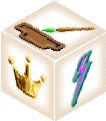
SolutionBox voice of this document:
INSIGHT • POLICY • PROGRAM |
posted: September 13, 2003 revised: April 18, 2004 • 20030913.242280.mt • 20040417.547890.mt •
• 20040418.534221.mt • (note: this document is about 35% finished) Matt Taylor 615 525 7053 me@matttaylor.com Copyright© Matt Taylor 2002, 2003, 2004 | |
|